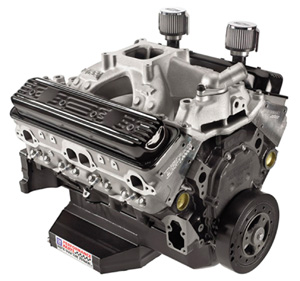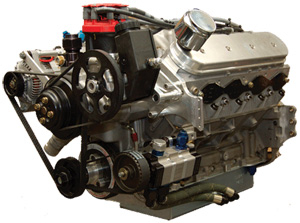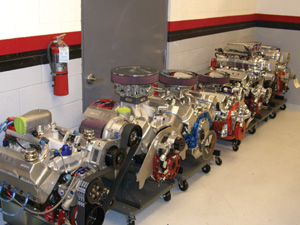By Brendan Baker
Senior Editor
Engine Builder Magazine
For many performance engine builders, the end of the year may be much busier than expected. While there is no racing going on in most parts of the country, there’s still plenty of preparation for next year. No doubt, some engine builders have been able to keep racing off their minds lately – even while watching “Dancing With The Stars,” where two time Indy 500 winner Helio Castroneves won the coveted Mirrorball Trophy – still others will end the racing season (or kick off the new one) in Orlando for the Advanced Engine Technology Conference (AETC) and the Performance Racing Industry (PRI) Trade Show.
The buzz around last year’s PRI Show was all about crate racing engines and how they could save short track racing. Well, by and large, it has reinvigorated a lot of racers who couldn’t afford the escalating costs of racing any more, and it’s brought in some fresh new racers also. That has been a good thing.
 But for racing engine builders it seems as though there is a darkening cloud looming on the horizon, ready to cast its shadow over what many have come to rely on: grassroots racing engine markets. No matter what part of the racing industry you service, chances are that you make much of your money at the regional level where the largest numbers of racers are concentrated.
But for racing engine builders it seems as though there is a darkening cloud looming on the horizon, ready to cast its shadow over what many have come to rely on: grassroots racing engine markets. No matter what part of the racing industry you service, chances are that you make much of your money at the regional level where the largest numbers of racers are concentrated.
According to a few racing analysts, short track racing was in big trouble before tracks and sanctioning bodies started adopting crate engine rules. The cost to go racing has always been high, but it had skyrocketed out of reach for some racers. Crate racing classes helps to keep people racing who normally wouldn’t be able to afford it. There are more racing organizations looking at crate and spec engines than ever before. But what will that cost be to engine builders who make their living building competitive custom race engines? This trend could limit an engine builder’s chances of gaining new business or even staying in business if he is not diversified in other areas.
According to A.J. Moore, competition director of Lake Erie Speedway, crate racing has been a success this year. Last year the track’s late model class was half “built” racing engines and the other half crates. Crate racing engines performed well enough that this year there were only seven “built” engines out of 30 or so regular entries. Moore says that only one built engine won a race this year, too. In part, those numbers are attributed to racers who have sold their built engines to purchase a crate, but also because there are rules that contain the performance of a built engine so it is equal to the crate engines.
 And equally upsetting to some engine builders is that unless your shop is an “authorized” crate engine rebuilder, you could be forced out of your local market or forced into looking for new tracks in your area with bigger “open” classes. The crate/spec racing engine phenomenon is reaching all levels of motorsports, and the sanctioning bodies and tracks need to contain costs seems to depend on cheaper, longer lasting engines as a big part of the solution.
And equally upsetting to some engine builders is that unless your shop is an “authorized” crate engine rebuilder, you could be forced out of your local market or forced into looking for new tracks in your area with bigger “open” classes. The crate/spec racing engine phenomenon is reaching all levels of motorsports, and the sanctioning bodies and tracks need to contain costs seems to depend on cheaper, longer lasting engines as a big part of the solution.
So how do you compete? Thinking outside the crate, if you will, is a good place to start.
“I think that crate engines have a place in racing at the support levels,” says Craiger Racing’s Craig Michaels, Clymer, NY. Michaels, an authorized crate race engine builder, says he and a few other local engine builders were asked to become Authorized Rebuilders by their local track, but the price was a bit steep at $5,000 for the privilege of rebuilding crate engines, which last longer and cost less to rebuild. The engine builders got together and decided that it was not worth the price to be involved, and if the track wanted them to rebuild engines for their series, they would have to come up with another solution. Finally, the track said that it would allow the engine builders to service the sealed crate engines if they joined the American Speed Association (ASA) — the series that created the crate engine rules and to which the majority of local tracks adhere for their own classes.
For Michaels and the other engine builders, this made much more sense. The pure fact of the matter is no one is getting wealthy building crate engines, except possibly GM Performance, whose 602 and 604 crate engines have become the standard for many series. There are other manufacturers involved in crate engine racing such as Ford and Chrysler, as well as production engine remanufacturers who supply engines, but the standard has been set by GM. Some tracks are looking at running GM only classes in the future to keep things more simplified.
 Michaels admits that the GM crate engines offer budget racers an equal platform. “If you check each of these engines, they’re probably within 25 hp of each other unless there’s something wrong with one. For a guy whose making 425 hp to someone else making 400, there’s a bit of an advantage there – but not much. You still have to have good tires on the car, and the car has to be setup well. Any driver who is reasonably talented is going to succeed anyway.”
Michaels admits that the GM crate engines offer budget racers an equal platform. “If you check each of these engines, they’re probably within 25 hp of each other unless there’s something wrong with one. For a guy whose making 425 hp to someone else making 400, there’s a bit of an advantage there – but not much. You still have to have good tires on the car, and the car has to be setup well. Any driver who is reasonably talented is going to succeed anyway.”
From a racer’s point of view, the lower cost crate engine means more racing for less money. But from an engine builder’s perspective, it can mean fewer high-dollar custom engines built, which is why some engine builders prefer to diversify so that one class can’t affect the bottom line too much.
Today, teams racing a spec class are mostly concerned about longevity and equally powered engines, as opposed to building a better mousetrap with more power than the competition. Innovation is moving away from the engine department to other areas of the racecar.
Many sanctioning bodies and racetracks have experimented with or are currently using a spec/crate engine program. Racing organizations that have taken to the crate engines include ASA, USAC (United States Auto Club) and numerous racetracks that run NASCAR Late Model Stock Cars. In most cases, the manufacturer or an authorized builder seals these engines so that the racing teams cannot perform any repairs or modifications. ASA, for example, uses a double redundant sealing system that must be displayed at all times. All engines, with or without this sealing process, are subject to testing and/or confiscation at any time during a sanctioned event.
Although each organization has different requirements for its crate engine programs, most follow similar rules to the ASA. Most require a seal be placed on the engine either by the organization or the builder. The engines will then need to go back to the builder or other authorized location for repair or rebuilding.
“As an engine builder, if some organization’s going to put engine rules in, obviously, that gets my attention,” Michaels says. “All I want is to be able to go to work the next day, and be allowed to work on them. But I’m open minded enough to say it doesn’t have to be just me who works on these crate engines – let’s allow others as well. What about the father and son who have always built their own engines? Have rules that allow people to rebuild engines. The crate engine concept can work – but I think as a whole it still needs some fine tuning.”
Michaels says that crate engines have a place in racing in his opinion. “Certainly, they should be there for support series races. And if tracks and sanctioning bodies are going to put the rules in, allow engine builders to be a part of it.”
As far as policing the series, experts say sanctioning bodies should pull some of the rules off in the lower classes where there are more budget-oriented racers than at the higher levels. In lower classes they can sometimes barely keep it together enough to compete, let alone cheat.
“One of the first things we noticed with the crate engines was the seal,” says Michaels. “I’m an old tool and die maker so I could look at them and say ‘Well, someone made it to begin with.’ And racers are savvy enough to figure out how to get around the rules.”
The early seals were similar to what are often found on your electric box, and people have been breaking into those for years. Enforcing the seal became a little more complicated when special seal bolts were introduced. But, miraculously, experts say bolts were soon available on the internet.
“The first seal bolts we saw were going out in guys’ lunch boxes,” says Michaels. “Give someone an easy way to make $300 with a set of $18 bolts and if he’s desperate enough he’ll often take it. They were the original bolts. And with someone who has the right knowledge it’s not that difficult to take those bolts and reproduce them exactly.”
The next step: the rules makers encrypted the bolts. And what did the racers do then? They found a way to encrypt the bolts themselves, because you can never underestimate what a racer will do to compete.
If You Can’t Beat ’em, Join ’em
So on the surface of things, it may appear to be all doom and gloom for race engine builders when, in reality, opportunities abound in crate and spec engine classes.
For instance, as an engine builder you may wish to work with a promoter, sanctioning organization or racetrack to develop an in-house crate engine program using your engines or engines that you service. One of the best options to look at is becoming an authorized rebuilder in your area for classes that run crate engines. In most cases, this option (of being bonded) will not be without cost, but terms can often be negotiated. And there are other services that racetracks need such as dyno service and tech inspection help. However, one engine builder warns that you should not take on the sole responsibility for policing a crate engine series.
Michaels acknowledges that while the crate engine rules are not what they should be at the moment, he believes that in time things will improve. “The rules were intended to lower the cost of racing, but in the past we would have racers who could buy three or four engines and check each one for the best they could get and then sell the others. Of course, you still have most guys doing it the right way, but some will always go to greater lengths than others for an advantage.”
Experts caution that the more the rules limit people from working on cars or engines then the more difficult it will be to enforce them. For example, if you have a guy who is a dominant force, then obviously you have to take a good look at what he’s running.
“We would see engines in which the timing had been obviously retarded and so on,” says Michaels. “I’ve been doing this for a long time and we have a lot of people who have a lot of experience. So it’s pretty hard to fool us. We can be fooled, but it’s not easy.”
But if an organization is going to install rules, then they should be responsible to check them. Engine builders shouldn’t have to buy a carburetor for some track’s rule. Experts say that if promoters and racetracks want to make it difficult then they should be the ones to take the responsibility for their own rules. When racetracks have problems with racers who were a little too good, the racetracks will often ask the local engine-building experts to police them.
The rules may be black and white but racers often think in shades of gray.
“Crate engines are quite a bit more complicated than what the initial idea was,” says Michaels. “The idea was fine, but people forget how smart and savvy racers are. They are always looking for the unfair advantage. You’ll never stop cheaters completely.”
Michaels says that crate engines can last for a full season or more, and he has only seen handful of these engines so far. Last year he only dyno tested about six engines. He does charge for the dyno runs, but it’s very reasonable because he’s usually doing more than one. So he gives the track a volume break.
“Engine builders make a living building engines,” Michaels states. “And probably the largest percentages of people who buy crate motors are hobbyists. So you take a hobbyist and give him rules, that’s fine; but you also have to be sensitive to an engine builder who makes his living in this sport.”
One of the advantages engine builders are beginning to realize is the help they are getting from many of their local parts suppliers and engine parts buying groups. Engine kits designed to fit specific engines, contingency sponsorships and other forms of support may be available if you check with your preferred supplier.
But be sure your track’s crate or spec class rules allow this. Some crate engine class rules say you must buy parts from the manufacturer. One engine builder said that GM insists on running a piston that has been out of production for 10 years and costs more than $90.
It depends on who you talk to whether or not crate race engine rules are a good thing or a bad thing, but one thing is for certain: they are probably here to stay. With popularity rising, engine builders can complain, criticize and ignore the opportunities…or you can choose to rise to the occasion and look for ways to help form the rules and be involved. There is money to be made, for sure, but there is also a chance to help racers get to the next level, where your talents can really shine.
You don’t have to build unrestricted race engines for an elite division to be a success. The engine builders who find their way into spec and crate engine classes and service them well will find success because grassroots divisions are the backbone of the performance racing market.
So as we head into next year, keep in mind all the new trends and ways to use them to your best advantage. After all, that’s what racers do best.











